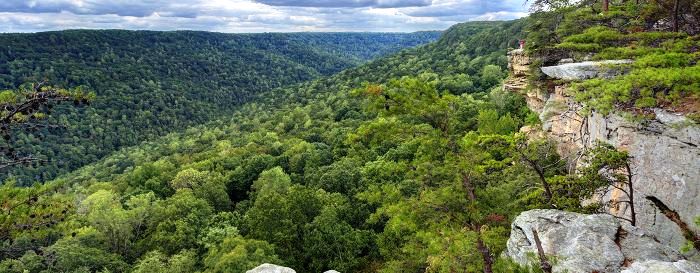Although it was primarily about community and regional revitalization, the landmark 2020 book, RECONOMICS: The Path To Resilient Prosperity, described how we can often restore two or more ecosystems—and make them more resilient—without even touching them…simply by reconnecting them to each other, such as by restoring some old farmland that separated them. This allows for migration (especially seasonal) of wildlife, and other essential flows.
Now, on December 20, 2021, The Conservation Fund has accomplished a successful “restoration via reconnection” project. And, in this case, it only required the writing of a check (although active restoration of mountain grassland meadows will be undertaken).
That was when they announced the addition of roughly 1101 acres to the Bear Hollow Mountain Wildlife Management Area (WMA) in southcentral Tennessee, in partnership with the Open Space Institute (OSI), The Nature Conservancy in Tennessee (TNC), and the Tennessee Wildlife Resources Agency (TWRA).
Adding this property—known as the Corum tract—to the Bear Hollow Mountain WMA was a top priority for TWRA. The addition connects two sections of the existing WMA that were previously divided by the Corum property, improving continuity of state-owned land and expanding protected habitat for wildlife and recreation.
The Conservation Fund purchased the Corum property in March of 2021 to buy time for TWRA to secure necessary funds for its purchase. Now, Corum has been officially transferred to the agency for their permanent ownership as part of the WMA.
“Connectivity of protected landscapes like this one are essential for forest health, habitats, and climate resiliency,” said Ralph Knoll, The Conservation Fund’s Tennessee State Director. “We’re thrilled to see this acquisition of Corum complete, as it builds off of decades of conservation work that we’re achieving across Tennessee in partnership with TWRA, OSI, TNC and Tennessee’s Congressional delegation.”
The Corum addition is made up of mostly forested land that is highly ranked for terrestrial habitats and Karst attributes—very unique rocky landscapes. The property provides suitable habitat for eight bat species of “Greatest Conservation Need,” including three federally listed species. Corum also supports several federally listed plant species, including Price’s Potato Bean and Moorefield’s Leather-flower.
“Not only does this purchase offer connectivity to the landscape but protects critical habitat for a number of wildlife species of Greatest Conservation Need and provides additional outdoor recreational opportunities in this part of the state. Thanks to all the parties involved in making this conservation effort a true success,” said Wally Akins, Assistant Chief, Wildlife and Forestry Division, Tennessee Wildlife Resources Agency.
Funding for this effort was made possible, in part, through generous support from OSI. Additional funding was secured by The Nature Conservancy of Tennessee through three donations from the Riverview Foundation, the WestRock Foundation, and a private estate gift.
“OSI is proud to have supported this astounding conservation success for Bear Hollow Mountain WMA, and for the people of Tennessee,” said Joel Houser, OSI’s Southeast Field Coordinator. “This land will remain viable habitat for biodiversity, even as the climate changes. We salute The Conservation Fund, The Nature Conservancy, and the Tennessee Wildlife Resources Agency, for their tireless efforts on behalf of Tennessee’s natural places.”
TWRA’s acquisition was enabled by the U.S. Forest Service’s Forest Legacy Program through the federal Land and Water Conservation Fund, which is allocated annually by the U.S. Congress. Tennessee’s U.S. Congressional delegation representing Franklin County includes U.S. Senator Marsha Blackburn, U.S. Senator Bill Hagerty, and U.S. Representative Scott DesJarlais.
“The forests and streams of southeast Tennessee provide so many things for people and nature: multi-use public recreation opportunities, protected wildlife habitats, and clean air and water, to name just a few. The Nature Conservancy is grateful for the chance to assist The Conservation Fund’s purchase of the Corum tract,” says Terry Cook, TNC’s Tennessee State Director.
The 17,000± acre Bear Hollow Mountain WMA has extensive second growth hardwood forests. Some of the ridgetops have been cleared for the restoration of native warm grasses, which in combination with the hardwood forests provide excellent habitat for Neotropical migratory songbirds. There are developed hiking trails including to an overlook, and the area is popular for wildlife viewing and hunting.
Photo of Bear Hollow Mountain Wildlife Management Area courtesy of Open Space Institute/Chuck-Sutherland.

